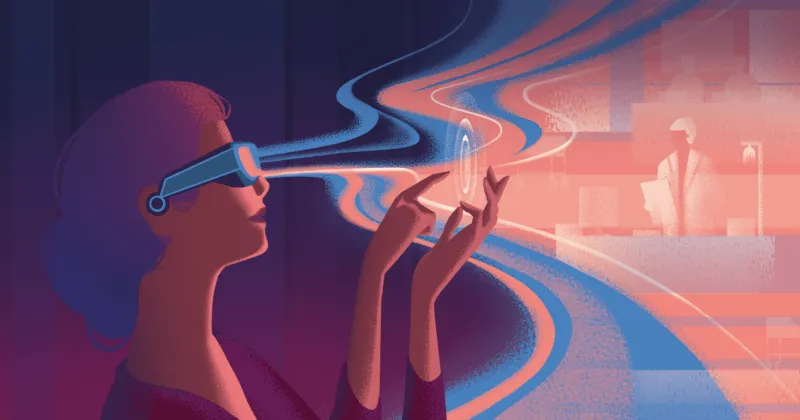
When it comes to Virtual Reality, people first think of gaming devices. But VR is gradually becoming more than just entertainment. The technology has a positive impact on the healthcare industry and is used in various processes, from training students to patient rehabilitation. Let's take a look at simulated environments in medicine and the future of VR in healthcare.
The statistics of VR in healthcare
Virtual reality is a technology that creates a computer-simulated environment with the help of a VR headset and special software. A user interacts with the virtual world using 3D glasses and haptic gloves.
The architecture of VR medical apps depends on their purpose. As a rule, an average platform includes the following components:
- a user VR application with a VR visualization module;
- a database including 3D models, scenarios, and users;
- a web administration panel.
According to Goldman Sachs Global Investment Research, the healthcare sector is second only to the video game industry in terms of VR usage. According to Research and Markets, the VR market in the medical industry is growing at a staggering pace and will increase from $36.9 million in 2020 to $2.2 billion in 2027. Let's see what is the reason for such popularity of VR in healthcare.
VR use cases in healthcare
Virtual reality has been adopted in many areas of healthcare and has become the basis for medical applications. The technology has proven effective in the education of medical students, training of doctors, pain management, rehabilitation of patients, and so on.
Training of medical students and doctors
The consulting company Accenture surveyed medical workers. 82% of experts confirmed that VR in healthcare is a good way to educate medical students and practicing physicians.
Any medical situation is simulated with the help of VR. Students solve the problem, receive detailed feedback on errors, and master their skills. It becomes easier to memorize information because all actions are taken in practice. For example, a VR application models the human body, presenting each part in minute detail. Students study anatomy using a computer model or learn how to perform a surgical operation. It is a safe way to learn, and its efficiency was proven by the American Board of Internal Medicine (ABIM). VR application provides more accurate knowledge.
Virtual reality helps practitioners to plan surgeries and train for complex procedures. A patient is safe because doctors are prepared for the unexpected. A VR application simulates a patient with their physical parameters (CT, MRI, medical ultrasound results). Such rehearsals help to reduce the number of errors during surgery.
Patient treatment
Accenture also found that 62% of patients would gladly accept VR services as an alternative to traditional medical treatment. Besides, the technology is used to treat physical and mental diseases:
- Anxiety disorder treatment. Approximately 18% of people in the world suffer from anxiety disorders. Psychosomatics affects the quality of human life and physical health. VR offers alternative treatment for post-traumatic stress disorder (PTSD), panic disorder, and other conditions. Patients enter a relaxing VR environment where they learn to manage anxiety and control emotions. Such therapy is effective, just like meditation or yoga.
- Recovery of patients with severe pain. With the help of VR medical apps, patients who have come through complex operations (skin transplantation, severe burns), patients with chronic pain, and children distract from pain and learn to manage it. This method is especially useful when patients are forbidden to take painkillers.
- Robotic surgery. Virtual reality allows a surgeon to control the movements of a robotic arm during an operation. The robot makes neat, small cuts that would be difficult for a human to make. As a result, a patient has fewer wounds, loses less blood, recovers faster, takes fewer painkillers in comparison with traditional surgery.
Recovery
Virtual reality is used in physiotherapy to help patients to recover from serious illnesses. An interactive environment distracts them from pain and motivates them to move. VR-powered physical exercise supports motor learning. For example, stroke patients perform specific movements without the fear of falling and being hurt. As they succeed, they begin to move more confidently in real rooms.
Maintaining physical activity
Virtual reality is becoming a part of fitness applications, motivating people to maintain daily physical activities. VR training is exciting as an application sets goals and rewards people for achieving them. The platform creates a background image that makes exercises even more pleasant: with the help of VR, you may find yourself on the seashore or the planet Mars. Some apps, like FitXR, allow you to organize live workouts together.
Conclusion
VR in healthcare is a new effective way of training doctors, treating patients, and maintaining physical activities. Although it is still not available to all clinics due to the high cost, the future of this technology is promising.
To implement VR medical apps in a hospital, it is necessary to elaborate a project in cooperation with a healthcare software development company. The IT partner will assess the needs of the organization, consider the structure and design of the software, create and test the VR environment. A team of specialists will make sure that the application complies with ISO, HIPAA, GDPR security requirements. They will also help the hospital staff to master the program and implement it in medical practice.
